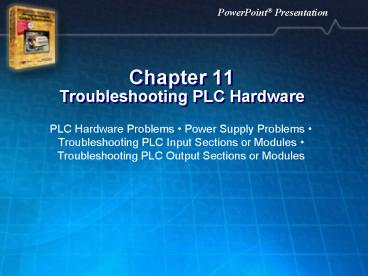Chapter 11 Troubleshooting PLC Hardware - PowerPoint PPT Presentation
1 / 23
Title:
Chapter 11 Troubleshooting PLC Hardware
Description:
Chapter 11 Troubleshooting PLC Hardware PLC Hardware Problems Power Supply Problems Troubleshooting PLC Input Sections or Modules Troubleshooting PLC ... – PowerPoint PPT presentation
Number of Views:58
Avg rating:3.0/5.0
Title: Chapter 11 Troubleshooting PLC Hardware
1
Chapter 11Troubleshooting PLC Hardware
- PLC Hardware Problems Power Supply Problems
Troubleshooting PLC Input Sections or Modules
Troubleshooting PLC Output Sections or Modules
2
- PLCs are designed for use with all common supply
voltages, such as 230 V, 208 V, 115 V, and 24 V.
3
- When problems occur with PLC power supplies,
input and/or output modules, or any system
components, a check of the supplied power should
be performed over time using a test instrument
with a recording function.
4
- Short circuits typically occur when conductor
insulation is damaged, which allows a
current-carrying conductor to come in contact
with any grounded noncurrent-carrying metal
parts. An overload is an overcurrent condition
that occurs when circuit current exceeds normal
PLC operating current and/or designed circuit
current.
5
- Voltage measurements can be used to test fuses
that are connected to a circuit.
6
- Resistance measurements are used to test fuses
that have been removed from a circuit.
7
- Circuit breakers perform the same function as
fuses and are basically tested the same way.
8
- Control transformers are typically used to step
down 115 VAC, 208 V, 230 V, or 460 V to 12 VAC
or 24 VAC for control circuit use in a PLC
enclosure.
9
- When the power rating of a transformer is
exceeded by placing too great a load on the
transformer, the voltage on the secondary side
will start to decrease and circuit problems will
develop.
10
- PLCs can have a single fixed voltage rating or a
dual voltage rating. Dual voltage rated PLCs
(115/230 VAC) have a selector switch (or movable
links) to set the PLC to one of the possible
voltage ratings.
11
- Output power supplies of PLCs are typically used
to supply voltage to input devices connected to
the PLCs.
12
- The listed current rating of a power supply must
be accepted as the maximum amount of current that
can safely be provided from a PLC output power
supply.
13
- When an input signal is sent to a PLC, the PLC
conditions, filters, and optically isolates the
signal.
14
- When troubleshooting PLC input sections,
programming diagrams and manufacturer
troubleshooting charts indicate how input devices
are connected and which output components are
being controlled.
15
- Testing input modules requires that power
supplies and input devices be tested and that
status lights of input modules and symbols on
computer monitors be checked.
16
- All input devices and the PLC program must
operate correctly in order for an automated
circuit to operate properly.
17
- Proper heat sinking and cooling is required with
solid-state devices to eliminate any potential
heat problems.
18
- The current that flows through an open
solid-state switch is called leakage current.
Leakage current can turn on the input circuitry
of a PLC, affecting system operation.
19
- Testing the leakage current of solid-state
devices requires that the OFF state leakage
current measurement be compared to the specified
minimum operating current of the PLC input module.
20
- Signals from the CPU of a PLC are sent through
logic circuits to output section status lights
and opto-isolation circuits before being sent to
output terminals.
21
- When troubleshooting PLC output sections,
programming diagrams and manufacturer
troubleshooting charts help the
troubleshooter/technician understand how the
input devices are connected and which output
components are being controlled.
22
- Testing output modules requires that power
supplies and output components be tested and that
status lights of output modules and symbols on
computer monitors be checked.
23
- All output components and the PLC program must
operate correctly in order for an automated
system to operate properly.































